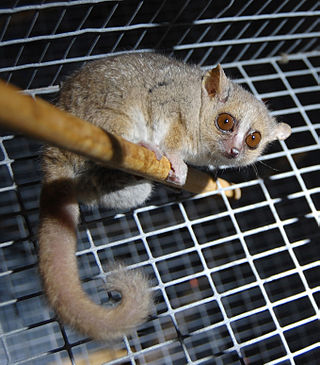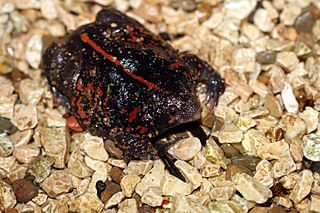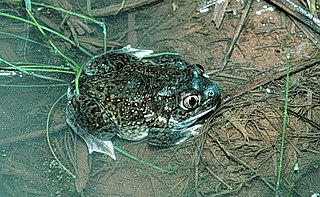Related Research Articles

The gray mouse lemur, grey mouse lemur or lesser mouse lemur, is a small lemur, a type of strepsirrhine primate, found only on the island of Madagascar. Weighing 58 to 67 grams, it is the largest of the mouse lemurs, a group that includes the smallest primates in the world. The species is named for its mouse-like size and coloration and is known locally as tsidy, koitsiky, titilivaha, pondiky, and vakiandry. The gray mouse lemur and all other mouse lemurs are considered cryptic species, as they are nearly indistinguishable from each other by appearance. For this reason, the gray mouse lemur was considered the only mouse lemur species for decades until more recent studies began to distinguish between the species.

Embryonic diapause (a.k.a.delayed implantation in mammals) is a reproductive strategy used by a number of animal species across different biological classes. In most species, the process occurs at the blastocyst stage of embryonic development and is characterized by a dramatic reduction or complete cessation of mitotic activity, arresting most often in the G0 or G1 phase of division.
The estrous cycle is a set of recurring physiological changes induced by reproductive hormones in females of mammalian subclass Theria. Estrous cycles start after sexual maturity in females and are interrupted by anestrous phases, otherwise known as "rest" phases, or by pregnancies. Typically, estrous cycles repeat until death. These cycles are widely variable in duration and frequency depending on the species. Some animals may display bloody vaginal discharge, often mistaken for menstruation. Many mammals used in commercial agriculture, such as cattle and sheep, may have their estrous cycles artificially controlled with hormonal medications for optimum productivity. The male equivalent, seen primarily in ruminants, is called rut.

The term spiny mouse refers to any species of rodent within the genus Acomys. Similar in appearance to mice of the genus Mus, spiny mice are small mammals with bare, scaled tails. However, their coats are endowed with unusually stiff guard hairs similar to the spines of a hedgehog; this trait is the source of the common name, spiny mouse.

The Mexican burrowing toad is the single living representative of the family Rhinophrynidae. It is a unique species in its taxonomy and morphology, with special adaptations to assist them in digging burrows where they spend most of their time. These adaptations include a small pointed snout and face, keratinized structures and a lack of webbing on front limbs, and specialized tongue morphology to assist in feeding on ants and termites underground. The body is nearly equal in width and length. It is a dark brown to black color with a red-orange stripe on its back along with splotches of color on its body. The generic name Rhinophrynus means 'nose-toad', from rhino- (ῥῑνο-), the combining form of the Ancient Greek rhis and phrunē.

A polyphenic trait is a trait for which multiple, discrete phenotypes can arise from a single genotype as a result of differing environmental conditions. It is therefore a special case of phenotypic plasticity.

Antechinus is a genus of small dasyurid marsupial endemic to Australia. They resemble mice with the bristly fur of shrews.

The fat-tailed dunnart is a species of mouse-like marsupial of the Dasyuridae, the family that includes the little red kaluta, quolls, and the Tasmanian devil.

The golden spiny mouse gets its name from the reddish-orange spiny fur that covers its body from head to tail. This coarse, inflexible fur is thought to protect it from predation. Aside from the golden fur that covers its head and upper parts, its flanks are yellow and its underside is pale. It has gray legs with pale feet and black soles. It is also described as having a small, but distinct white spot under each eye. It is often found in the wild missing a part or all of its tail because it is able to shed this as a defense mechanism. However, it is not known how this is done, how often it can occur, or under what conditions. It lives an average of three years in the wild. It is omnivorous and feeds on seeds, desert plants, snails, and insects. Living in desert regions, it is a xeric animal that obtains water from the plants that it eats and produces very concentrated urine in order to conserve water. A. russatus is naturally nocturnal, but adapts to being diurnal when it shares a habitat with A. cahirinus.

The plains spadefoot toad is a species of American spadefoot toad which ranges from southwestern Canada, throughout the Great Plains of the western United States, and into northern Mexico. Like other species of spadefoot toads, they get their name from a spade-like projection on their hind legs which allows them to dig into sandy soils. Their name, in part, comes from their keratinized metatarsals, which are wide instead of "sickle shaped". The species name translates as buzzing leaf shaped. This refers to the species' distinguishing features; its buzzing mating call, and its leaf-shaped digging metatarsals. It was first described by Cope in 1863.

Rhabdomys is a largely Southern African genus of muroid rodents slightly larger than house mice. They are known variously as striped or four-striped mice or rats. Traditionally the genus has been seen as a single species, Rhabdomys pumilio, though modern evidence on the basis of karyotype and mtDNA analysis suggests that it comprises two or more species and subspecies. Dorsally Rhabdomys species display four characteristic black longitudinal stripes on a paler background.

The reddish-gray mouse lemur also known as the gray-brown mouse lemur or rufous-gray mouse lemur, is a small, solitary-but-social, nocturnal and omnivorous primate from the Western Madagascar in the region around Beza Mahafaly Reserve, north to Lamboharana. Like the other lemur species, the reddish-grey mouse lemur is endemic to Madagascar. They generally live in the drier regions of the island. It is categorized as least concerned in the IUCN Red List.

The Cairo spiny mouse, also known as the common spiny mouse, Egyptian spiny mouse, or Arabian spiny mouse, is a nocturnal species of rodent in the family Muridae. It is found in Africa north of the Sahara, where its natural habitats are rocky areas and hot deserts. It is omnivorous and feeds on seeds, desert plants, snails, and insects. It is a gregarious animal and lives in small family groups. It is the first and only known rodent species that exhibit spontaneous decidualization and menstruation.

The Cape spiny mouse is a murid rodent found in the Western Cape province of South Africa. They have a dorsal covering of spiny hairs with dark grey-brown colouration, and a white underbelly. The Cape spiny mouse has large eyes and ears and a scaly, nearly bald tail that is brittle and can break off readily either as a whole or in part if it is caught. Their total length is 17 cm (6.7 in), with an 8 cm (3.1 in) tail, and they typically weigh 22 g (0.78 oz).
Seasonal breeders are animal species that successfully mate only during certain times of the year. These times of year allow for the optimization of survival of young due to factors such as ambient temperature, food and water availability, and changes in the predation behaviors of other species. Related sexual interest and behaviors are expressed and accepted only during this period. Female seasonal breeders will have one or more estrus cycles only when she is "in season" or fertile and receptive to mating. At other times of the year, they will be anestrus, or have a dearth of their sexual cycle. Unlike reproductive cyclicity, seasonality is described in both males and females. Male seasonal breeders may exhibit changes in testosterone levels, testes weight, and fertility depending on the time of year.
Menstruation is the shedding of the uterine lining (endometrium). It occurs on a regular basis in uninseminated sexually reproductive-age females of certain mammal species.
The challenge hypothesis outlines the dynamic relationship between testosterone and aggression in mating contexts. It proposes that testosterone promotes aggression when it would be beneficial for reproduction, such as mate guarding, or strategies designed to prevent the encroachment of intrasexual rivals. The positive correlation between reproductive aggression and testosterone levels is seen to be strongest during times of social instability. The challenge hypothesis predicts that seasonal patterns in testosterone levels are a function of mating system, paternal care, and male-male aggression in seasonal breeders.

In zoology, copulation is animal sexual behavior in which a male introduces sperm into the female's body, especially directly into her reproductive tract. This is an aspect of mating. Many animals that live in water use external fertilization, whereas internal fertilization may have developed from a need to maintain gametes in a liquid medium in the Late Ordovician epoch. Internal fertilization with many vertebrates occurs via cloacal copulation, known as cloacal kiss, while mammals copulate vaginally, and many basal vertebrates reproduce sexually with external fertilization.
A circannual cycle is a biological process that occurs in living creatures over the period of approximately one year. This cycle was first discovered by Ebo Gwinner and Canadian biologist Ted Pengelley. It is classified as an Infradian rhythm, which is biological process with a period longer than that of a circadian rhythm, less than one cycle per 24 hours. These processes continue even in artificial environments in which seasonal cues have been removed by scientists. The term circannual is Latin, circa meaning approximately and annual relating to one year. Chronobiology is the field of biology pertaining to periodic rhythms that occur in living organisms in response to external stimuli such as photoperiod.

Capital breeding and income breeding refer to the methods by which some organisms perform time breeding and use resources to finance breeding. In the models, capital breeders breed when they reach a threshold condition, which decreases throughout the breeding season. However, the original definition of a capital breeder has changed, with the more recent definition being organisms that use energy stores built up before reproduction to breed. This is in comparison to income breeders, who breed after certain levels, which do not change, of increase in condition are reached and who use energy gained during breeding to finance reproduction. Income breeders who are growing especially fast hold off the development of their offspring after a threshold is reached so they can produce more offspring, although this does not occur in slower growing income breeders. An organism can be both a capital and an income breeder; the parasitoid Eupelmus vuilletti, for example, is an income breeder in terms of sugars, but a capital breeder in terms of lipids. A different example of the interaction between capital and income breeding is found in Vipera aspis; although these snakes are capital breeders, they lay larger litters when food is abundant, which is a characteristic of income breeders.
References
- 1 2 WE Duellman, L Trueb. Biology of amphibians. The Johns Hopkins University Press, 1994, p. 20
- ↑ Malpoux B. The Neuroendocrine Control of Seasonal Rhythms. In: Conn PM, Freeman ME, ed., Neuroendocrinology in physiology and medicine. Humana Press, 1999, p. 437
- 1 2 Martin R, Johnson P. Bennett's Tree-kangaroo. In: R. Straham, ed., Mammals of Australia, Washington, DC: Smithsonian Institution Press, 1995, pp. 307-8, PMID 16026787
- ↑ H.B. Tordoff; W.R. Dawson (1965). "The influence of daylength on reproductive timing in the red crossbill". The Condor. 67 (5): 416–22. doi:10.2307/1365634. JSTOR 1365634.
- ↑ T.P. Hahn (1995). "Integration of photoperiodic and food cues to time changes in reproductive physiology by an opportunistic breeder, the red crossbill, Loxia curvirostra (Aves: Carduelinae)". J. Exp. Zool. 272 (3): 213–26. doi:10.1002/jez.1402720306.
- 1 2 U. Shanas; A. Haim (2004). "Diet salinity and vasopressin as reproduction modulators in the desert-dwelling golden spiny mouse (Acomys russatus)". Physiology and Behavior. 81 (4): 645–50. doi:10.1016/j.physbeh.2004.03.002. PMID 15178158. S2CID 8150833.
- ↑ Hugh Tyndale-Biscoe (22 April 2005). Life of Marsupials. Csiro Publishing. pp. 342–. ISBN 978-0-643-09921-0.
- ↑ Wayne NL, Rissman EF (1990). "Environmental regulation of reproduction in an opportunistic breeder: the musk shrew (Insectivora: Suncus murinus)". Prog. Clin. Biol. Res. 342: 668–72. PMID 2381955.
- ↑ Fleming, P. A., and S. W. Nicolson. "Opportunistic breeding in the Cape spiny mouse (Acomys subspinosus)." African Zoology 37.1 (2002): 101-105.